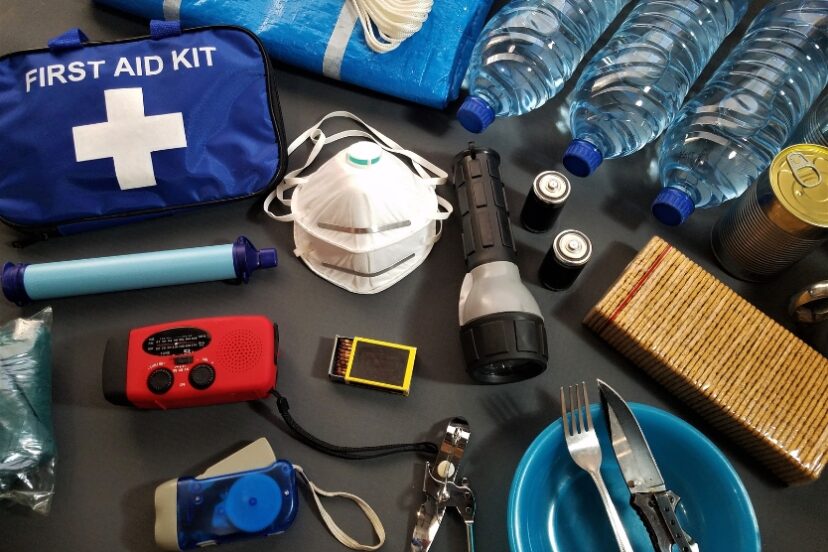When it comes to survival and prepping, your first aid kit isn’t just a box of…
How To Prepare For Civil Unrest With Home Security Measures

Civil unrest has the potential to disrupt daily life and pose risks to personal safety, making it essential to prioritize the security of your home and loved ones.
The comfort of knowing your household is prepared for unexpected events offers a sense of stability and control during uncertain times.
Preparation begins with identifying potential risks, reinforcing your home’s defenses, and developing strategies that ensure your family’s safety regardless of the surrounding conditions.
By taking deliberate and proactive measures, you can create a secure environment that provides peace of mind and resilience in the face of instability.
Start now by implementing crucial steps to safeguard your home and protect what matters most.
1)) Assess Potential Risks In Your Area
Understanding the specific risks and challenges in your local area is a crucial first step in preparing for potential civil unrest.
Start by researching recent incidents or patterns of disruption that might indicate vulnerable locations or targets nearby.
Pay attention to areas where large gatherings or protests are likely to occur, as these are often hotspots for escalating tension.
It’s important to stay informed through reliable news sources, community alerts, or even neighborhood forums to keep track of real-time developments.
By identifying these risk factors early, you can make well-informed decisions about safeguarding your home and finding safer routes or locations if movement becomes necessary.
This awareness lays the foundation for taking further protective measures tailored to the unique circumstances of your surroundings.
2)) Secure All Doors And Windows
Securing all doors and windows in your home is a critical step to enhance its overall safety during periods of civil unrest.
Start by ensuring that all entry points are equipped with sturdy locks, such as deadbolts or high-security mechanisms, which can deter forced entry.
Inspect the condition of frames and hinges to confirm that they can withstand pressure, replacing any weak or damaged components.
Consider reinforcing doors with strike plates or door braces and upgrading windows by applying safety film or installing shatter-resistant glass to prevent breakage.
For added protection, use sturdy window locks and secure sliding doors with bars or rods to block unwanted access.
Taking these precautions not only strengthens your home’s barriers but also provides peace of mind knowing your family is protected against potential threats.
3)) Install High-Quality Locks
Installing high-quality locks is an essential aspect of fortifying your home and safeguarding it from potential breaches.
Begin by selecting locks that are recognized for their durability and security features, such as ANSI Grade 1 deadbolts or smart locks with advanced encryption and tamper detection.
Evaluate your current locks to identify any outdated or easily compromised mechanisms, replacing them with modern solutions that provide enhanced protection.
Pay close attention to all entry points, including front and back doors, garage entrances, and any side doors, ensuring each is equipped with a robust locking system.
For sliding doors, consider using auxiliary locks or reinforced bars to block unauthorized access.
High-quality locks serve as a strong first line of defense, giving you greater confidence in your home’s ability to deter potential intruders and protect your loved ones.
4)) Add Outdoor Motion-Sensor Lights
Installing outdoor motion-sensor lights is a powerful strategy to increase your home’s security and deter potential intruders.
These lights automatically activate when movement is detected, creating an immediate visual alert that can startle trespassers and draw attention to suspicious activity.
Position motion-sensor lights around key areas of your property, such as entry points, driveways, pathways, and any dark or hidden corners that could be exploited.
Choose lights with a wide detection range and reliable sensitivity to ensure coverage of vulnerable zones.
Solar-powered or energy-efficient LED options are practical choices for long-term use, reducing maintenance needs while providing consistent illumination.
Incorporating these lights into your home’s exterior not only enhances safety but also fosters a sense of vigilance and control over your surroundings.
5)) Set Up A Monitored Security System
Setting up a monitored security system is a proactive way to ensure constant surveillance and protection for your home.
Modern security systems often include features such as door and window sensors, motion detectors, cameras, and alarm triggers that can alert both you and a professional monitoring service to any unusual activity.
Choose a system with reputable monitoring services that operate 24/7, providing a direct line of communication to law enforcement or emergency responders if an incident occurs.
Many systems also integrate with smart home technology, allowing you to remotely check camera feeds, arm or disarm alarms, and receive instant notifications on your smartphone.
Strategically placing cameras and sensors at all entry points and vulnerable areas ensures no blind spots are left unprotected.
A reliable monitored security system creates an added layer of protection and reassurance, helping you stay prepared for unexpected challenges.
6)) Reinforce Entry Points With Barricades
Reinforcing entry points with barricades significantly enhances your home’s defense by creating an additional physical barrier against unauthorized access.
Use devices such as metal security bars, door jammers, or portable barricades to secure doors and windows, ensuring they remain immovable in case of an attempted breach.
For doors, consider installing reinforced steel plates or braces that can withstand high impact, while for windows, heavy-duty grilles or bars can provide a strong deterrent without compromising visibility.
Evaluate potential access points like basement entrances or garage doors and fortify them with similar measures to prevent vulnerabilities.
When selecting barricading solutions, prioritize durable materials like steel or reinforced alloys that offer reliable protection against forceful entry.
Properly reinforced entry points not only delay intrusion attempts but also provide critical time for you to alert authorities or respond to the situation, bolstering the overall safety of your household.
7)) Create A Safe Room With Supplies
Creating a safe room with supplies is a practical step toward ensuring your family’s safety during emergencies.
Select a location within your home that is easily accessible but not immediately visible, such as a basement, closet, or interior room with no exterior windows.
Reinforce the room with sturdy doors, secure locks, and possibly even bullet-resistant or reinforced walls to provide maximum protection.
Stock the safe room with essential emergency supplies, including bottled water, non-perishable food, a first-aid kit, flashlights with extra batteries, communication devices like a fully charged cell phone or two-way radio, and important documents stored in waterproof containers.
Consider adding ventilation systems and emergency power sources to sustain comfort and functionality in case of prolonged use.
By carefully preparing and equipping a safe room, you create a secure environment where your family can retreat during dangerous situations, ensuring everyone’s safety and well-being.
8)) Stockpile Essential Emergency Items
Stockpiling essential emergency items is a crucial measure to prepare your household for unexpected situations.
Begin by gathering a comprehensive selection of non-perishable food and clean drinking water sufficient to last for at least several days.
Include first-aid supplies such as bandages, antiseptics, medications, and any necessary medical equipment to address health concerns during emergencies.
Equip your stockpile with practical tools like multi-purpose knives, flashlights, extra batteries, matches or lighters, and portable chargers to ensure functionality even in power outages.
Don’t forget hygiene products, including hand sanitizers, toilet paper, and feminine supplies, to maintain comfort and cleanliness.
It’s also important to keep a stash of cash in small denominations, as banking systems may be inaccessible. Store everything in waterproof containers and designate a secure, easily reachable storage area.
By being well-equipped, you can face emergencies with confidence, knowing your basic needs are met.
9)) Develop A Family Communication Plan
Developing a family communication plan is essential to ensure everyone knows how to stay connected and informed during emergencies.
Start by designating a meeting place both inside and outside your neighborhood where family members can regroup if separated.
Compile a list of important contact information, including phone numbers for each family member, nearby relatives, and emergency services, then distribute copies to everyone.
Equip your household with tools like charged cell phones, portable power banks, and, if possible, two-way radios for alternative communication.
Discuss and establish a clear chain of communication to avoid confusion, such as prioritizing text messages during network congestion.
Regularly practice your communication plan during emergency drills to confirm that everyone understands their role and knows how to execute the plan.
By having a well-thought-out strategy, you reduce the risk of miscommunication and ensure everyone’s safety no matter the situation.
Pro-Tip: Always keep a physical emergency preparedness checklist and emergency contact forms in an easily accessible location as part of your family’s communication plan.
These documents serve as reliable references during high-stress situations, especially if digital devices fail or are unavailable.
Ensure that the checklist includes critical steps, such as meeting points, necessary supplies, and safety protocols, while the contact forms should list all key numbers and addresses.
Regularly update these materials to keep the information current and accurate.
Start building your emergency preparedness toolkit today—download our printable checklist and contact form to get started!
10)) Stay Informed Through Reliable Sources
Staying informed through reliable sources is a vital aspect of preparing for and responding to emergencies effectively.
Identify trustworthy outlets, such as government agencies, local news channels, and weather services, that provide accurate and timely updates.
Subscribe to emergency alerts and notification systems, which can deliver critical information directly to your phone or email.
Regularly monitor these updates to stay aware of potential risks in your area, such as severe weather, public safety concerns, or evacuation orders.
Equip your household with tools like a battery-powered or hand-crank radio to access broadcasts even during power outages.
Be cautious of misinformation and cross-check any updates with authoritative sources before taking action.
Keeping yourself informed ensures you can make swift, informed decisions to protect your family and manage emergencies efficiently.
By staying connected to credible information, you reduce uncertainty and enhance your capacity to respond effectively to any situation.
Conclusion
Preparedness is the key to navigating emergencies with resilience and confidence.
By dedicating time to create safe spaces, stockpile critical supplies, establish communication plans, and stay informed through reputable sources, you empower yourself and your loved ones to face unexpected challenges effectively.
Each step you take enhances your ability to maintain safety, comfort, and peace of mind during uncertain situations.
Adopting preventive measures not only secures your immediate needs but also fosters a sense of control and readiness that can make all the difference when crises arise.
With careful planning and steadfast vigilance, you can protect what matters most and adapt to any circumstances that come your way.





